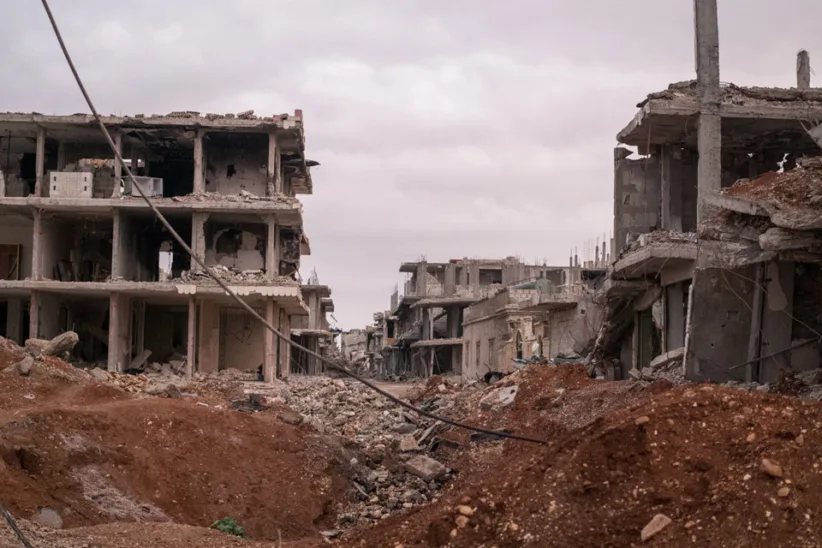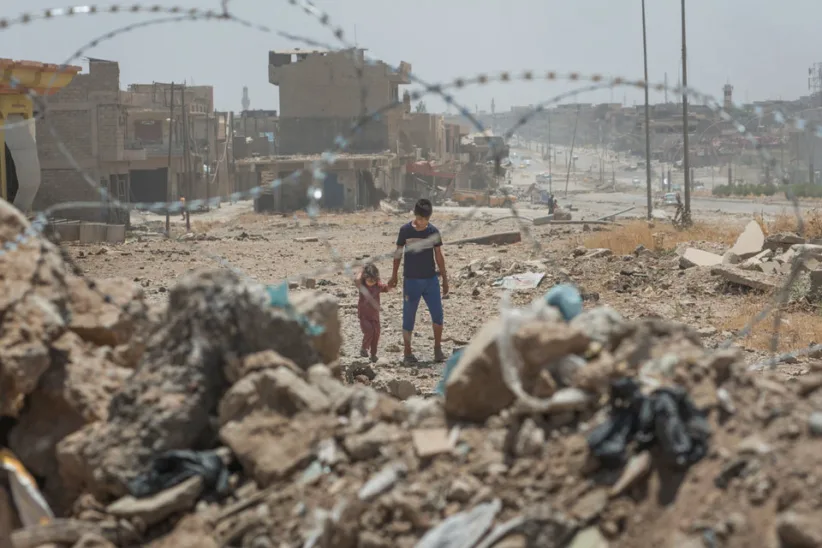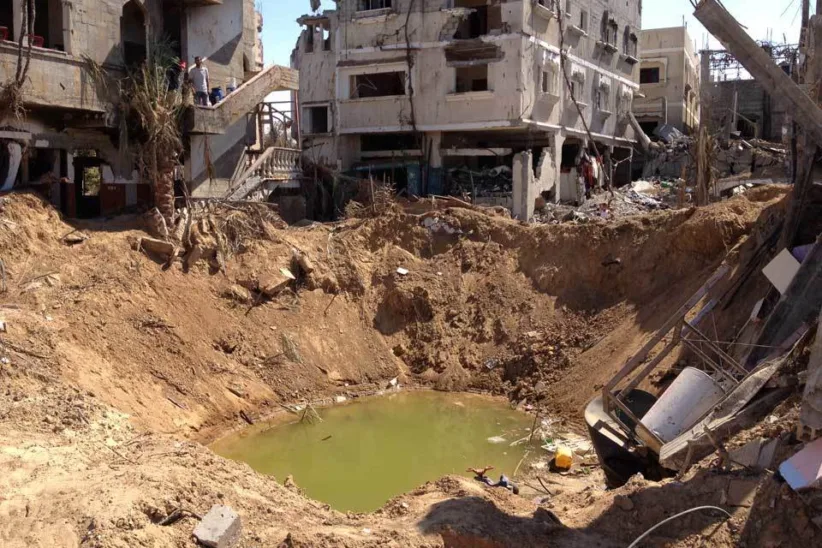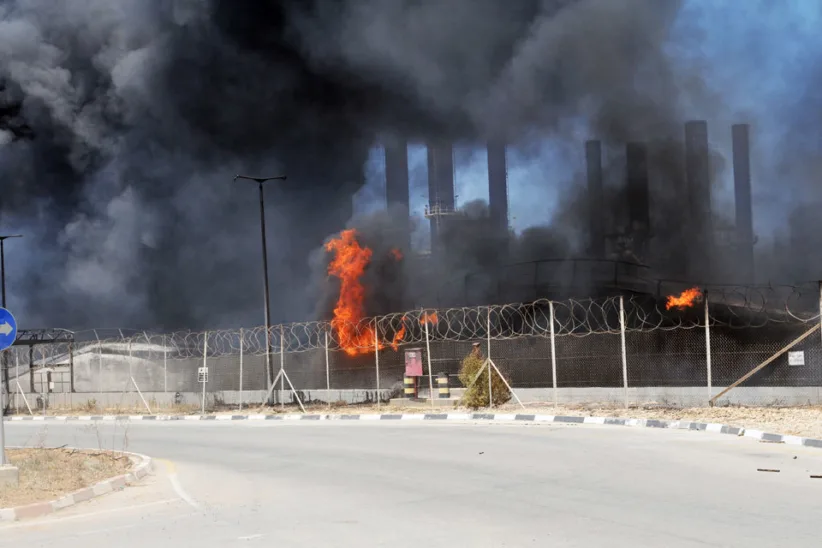Protecting the environment from the direct and reverberating effects of explosive weapons is a vital component of civilian protection.
With talks on a political declaration on the civilian harm caused by use of explosive weapons in populated areas nearing completion later this year, Linsey Cottrell and Kendra Dupuy argue that it’s critical that their environmental impact is also addressed.

Background
The use of explosive weapons in populated areas (EWIPA) is highly destructive, resulting in large numbers of civilian casualties and causing massive damage to civilian infrastructure and the environment. A political declaration on mitigating the humanitarian harm caused by EWIPA is currently being negotiated by governments, with Ireland leading the process. The latest version of the draft declaration incorporates the issue of EWIPA’s negative environmental effects, such as the contamination of air, soil, groundwater and other resources. However, the text could be strengthened further to reinforce the relationship between environmental protection and the protection of civilians, and to foreground best practice in mitigating the environmental legacy of EWIPA.
In March, the Conflict and Environment Observatory and Norwegian People’s Aid co-hosted a webinar on the environmental effects of EWIPA, and why mitigating them is a vital component of the protection of civilians.
The environment in populated areas
The environment is an important, integral, and inseparable part of populated areas, and it is difficult to draw a strong dividing line between the “natural” and populated environments. For this reason, we and others have urged states to refer to “the environment” throughout the declaration, rather than to the “natural environment”.
The health, well-being, and very survival of civilians in populated areas depend on having access to functioning sanitation, quality water supplies, clean air, and land that is fit-for-use. Ensuring safe and consistent access to these resources in turn depends on key infrastructure like electricity supplies, water and sewage treatment plants – infrastructure that often falls victim to the use of explosive weapons during conflict.

The negative environmental effects of EWIPA
Some of the major environmental effects of EWIPA are detailed in a recently published AOAV report. These are diverse and typically have wide-ranging and long-lasting effects. Buildings destroyed by explosive weapons can release toxic materials like asbestos, risking the health of people and presenting a long-term hazard, if not remediated. The forced displacement of civilians, which may be prolonged by urban destruction and the presence of explosive remnants of war (ERW), can also result in significant environmental effects far from affected areas. Displacement camps themselves can, if not properly designed, severely and negatively impact the local environment through, for instance, deforestation due to the overharvesting of firewood, or improper waste disposal.
Debris and solid waste management
Conflict-affected contexts pose unique challenges for dealing with the huge volumes of debris generated by the use of EWIPA. In Syria, the volume of debris generated from the destruction in Aleppo and Homs is estimated at 15 million tonnes and 5.3 million tonnes, respectively. Together, this is equivalent to about 10 times the volume of debris generated by the collapse of the World Trade Centre in 2001 (given as 1.8 million tonnes). Removing this took 108,342 truck journeys over nine months. Using these figures as a comparison, it would mean clearing debris from Aleppo and Homs alone would need more than 1 million truckloads, taking years to complete, generating emissions and pollution.
Environmental governance in conflict-affected areas is often already weak, with a lack of capacity to manage debris on such a large scale. As well as generating very large volumes, debris may contain ERW or other hazardous materials. This hinders the recovery of material and make debris difficult to recycle. The collapse of local governance and infrastructure also affects solid waste management systems, resulting in uncontrolled dumping, open burning of waste and co-disposal with conflict debris, which causes further contamination, also hinders recycling and negatively impacts the environment.
In the context of Iraq, our workshop detailed additional challenges to the management of ERW in urban debris. These have included a fragmented approach to decision-making, a large number of impacted sites to be managed over a huge geographical area, safety, time, costs, chemical contamination, and a linear rather than circular approach to debris management. A circular approach aims to recycle debris, rather than dispose of it, this reduces emissions, creates employment and reduces pressure on the environment.
To tackle the estimated 7-8 million tonnes of debris created by the conflict in Mosul, a project launched by UNEP in May 2021 aims to replace the conventional practice of debris clearance and dumping, with a new focus on recycling and use of the recycled aggregate in reconstruction. Without this, there is the risk of uncontrolled dumping and pressure on virgin sand and gravel resources for reconstruction. Sand and gravel quarrying along the banks of the River Tigris has been highly destructive. Best practice approaches like this should be referenced in the political declaration.
Water and urban infrastructure
Civilians in populated areas depend on the environment for the resources they need to live, including a safe water supply, accessed through urban infrastructure. Services like water supply are highly interdependent, relying on other services and infrastructure such as the electricity supply, water and wastewater treatment plants, and the water pipe system. Failure will not just disrupt the supply of safe water but affect the complex water cycle and risks wider environmental harm. Defunct wastewater treatment plants and collection systems can result in the contamination of groundwater, surface or coastal waters by untreated sewage, and thereby contaminating natural resources and impacting wider ecoservices. The use of EWIPA can therefore have geographically wider environmental consequences, impacting both people and ecosystems within and outside of urban areas.

Conflict-related pollution and contamination
There are multiple potential sources of pollution within urban settings, and proportionately more people vulnerable to the risk of exposure to contaminants. With commercial and industrial units, utility infrastructure, filling stations, workshops, fuel storage and garages all located in urban areas, the use of EWIPA can result in contamination and the release a host of toxic and hazardous chemicals from damaged buildings and infrastructure. This can create airborne contaminants and can contaminate water resources and underlying soils, negatively impacting human health through direct contact, inhalation or ingestion of chemicals. It can also create indirect pathways to exposure, for instance from leaching through soils, migrating to underlying groundwater and flowing into streams or rivers.
Typical contaminants of potential concern include metals like lead and chromium, fuel oils, PCBs, fire retardants, explosives and asbestos. Their presence will vary depending on location, urban setting, age and nature of construction materials and the type of land uses. Some contaminants will disperse and eventually degrade in the environment, but many do not and will persist for years.

Monitoring and responding to the environmental damage caused by EWIPA
Impact monitoring is critical to understand the environmental risks and damage caused by conflict, yet challenging to conduct on the ground. Environmental assessments are an important part of such efforts, but where there is no safe physical access to sites, analysis will be more generalised and may also not be well-suited to recording and tracking specific environmental incidents. Good relations with local actors and a systems-level understanding of EWIPA’s environmental effects are important.
There is a need for states to fully support the work of the UN and other stakeholders in identifying and implementing good practice in the assessment and management of conflict debris and pollution. In this respect, the EWIPA declaration should ensure that it is aligned with the resolutions of the UN Environment Assembly addressing conflict pollution and environmentally sound waste management.
Furthermore, as a recent UNIDIR report argues, systematic and comparable data collection and monitoring of environmental incidents related to EWIPA is needed to fully understand the scale of the problem. UNIDIR has proposed an initial set of indicators for monitoring EWIPA’s reverberating effects, but this must be complemented and developed further to include conflict pollution and environmental degradation.
Measures needed going forward
The political declaration’s recognition of the environmental effects of EWIPA is a step in the right direction, but much more remains to be done. The environmental impacts of EWIPA should be acknowledged through revised military practices, including adherence to the ICRC’s guidelines to strengthen the protection of the environment in armed conflict. National authorities and other stakeholders should identify and implement the best practices dealt with above on data collection and debris management. Meanwhile utilising the framework developed by Harvard University and CEOBS for assisting victims of conflict pollution would help to address the harm caused by EWIPA.
More fundamentally, the most effective way to reduce the tens of thousands of civilian deaths and injuries caused each year by explosive weapons is to stop the deployment of explosive weapons with wide-area effects in populated areas.
A useful summary of the most recent consultations on the EWIPA political declaration has been prepared by Reaching Critical Will, with calls from a number of states, the ICRC and NGOs to strengthen its language on the environment. Only Israel wanted to see the reference to environment to be removed. Written submissions received from states and civil society can be viewed here.
Linsey Cottrell is CEOBS’ Environmental Policy Officer, Kendra Dupuy is NPA’s Senior Adviser on the environment. Talks on the EWIPA political declaration are expected to conclude in September.
